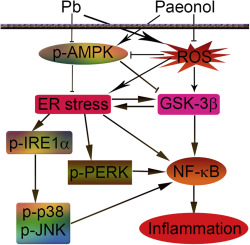Food and Chemical Toxicology ( IF 4.3 ) Pub Date : 2018-10-06 , DOI: 10.1016/j.fct.2018.10.024 Chan-Min Liu , Hui-Xin Yang , Jie-Qiong Ma , Wei Yang , Zhao-Jun Feng , Jian-Mei Sun , Chao Cheng , Jun Li , Hong Jiang

|
Paeonol is a natural flavonoid isolated from Moutan Cortex, which has been found to exhibit antioxidant, anti-apoptotic, anti-aging and anti-inflammatory bioactivities. Herein, we investigated the nephroprotective efficacy of paeonol against Pb-induced toxicity and elucidated the potential mechanisms. The results revealed that paeonol significantly ameliorated renal dysfunction and histology changes of Pb-treated mice. Paeonol inhibited oxidative stress and increased activities of antioxidant enzyme in the kidneys of Pb-treated mice. Paeonol decreased the nuclear factor-κB activation and over-production of inflammatory cytokines tumor necrosis factor-alpha (TNF-α) and interleukin-6 (IL-6). Paeonol suppressed endoplasmic reticulum (ER) stress in kidneys of in the Pb treatment group and primary kidney mesangial cells. Moreover, paeonol increased the denosine 5‘-monophosphate-activated protein kinase (AMPK) phosphorylation and decreased the activations of glycogen synthase kinase-3 (GSK-3), protein kinase RNA-like ER kinase (PERK), inositol-requiring protein-1 (IRE1), c-jun N-terminal kinase (JNK) and p38 mitogen-activated protein kinase (MAPK). These results were further confirmed in primary kidney mesangial cells. Taken together, these findings indicate that paeonol could protect kidney form Pb-induced injury by inhibiting oxidative stress, ER stress and inflammation via the AMPK and GSK-3 pathway. Paeonol might be a potential therapeutic agent to inhibit ER stress-associated inflammation in lead-stimulated kidneys.
中文翻译:

AMPK通路在铅诱导的肾脏内质网应激和丹皮酚对小鼠的保护中的作用
丹皮酚是从牡丹皮中分离出的天然黄酮,已被发现具有抗氧化,抗凋亡,抗衰老和抗炎的生物活性。在这里,我们调查了丹皮酚对铅诱导的毒性的肾保护功效,并阐明了潜在的机制。结果表明,丹皮酚显着改善了Pb处理的小鼠的肾功能不全和组织学变化。丹皮酚可抑制Pb处理的小鼠肾脏中的氧化应激并增加抗氧化酶的活性。丹皮酚可降低炎性细胞因子肿瘤坏死因子-α(TNF-α)和白细胞介素-6(IL-6)的核因子-κB活化和过度生产。丹皮酚可抑制Pb治疗组的肾脏和原代肾小球系膜细胞的内质网(ER)应激。而且,eon药酚增加了5'-单磷酸腺苷激活的蛋白激酶(AMPK)的磷酸化,并降低了糖原合酶激酶3(GSK-3),蛋白激酶RNA样的ER激酶(PERK),需要肌醇的蛋白1( IRE1),c-jun N末端激酶(JNK)和p38丝裂原活化蛋白激酶(MAPK)。这些结果在原发性肾小球膜细胞中得到了进一步证实。综上所述,这些发现表明丹皮酚可以通过抑制AMPK和GSK-3途径的氧化应激,ER应激和炎症来保护Pb诱导的肾脏损伤。丹皮酚可能是抑制铅刺激肾脏中与内质网应激相关的炎症的潜在治疗剂。蛋白激酶RNA样ER激酶(PERK),需要肌醇的蛋白1(IRE1),c-jun N末端激酶(JNK)和p38丝裂原激活的蛋白激酶(MAPK)。这些结果在原发性肾小球膜细胞中得到了进一步证实。综上所述,这些发现表明丹皮酚可以通过抑制AMPK和GSK-3途径的氧化应激,ER应激和炎症来保护Pb诱导的肾脏损伤。丹皮酚可能是抑制铅刺激的肾脏内质网应激相关炎症的潜在治疗剂。蛋白激酶RNA样ER激酶(PERK),需要肌醇的蛋白1(IRE1),c-jun N末端激酶(JNK)和p38丝裂原激活的蛋白激酶(MAPK)。这些结果在原发性肾小球膜细胞中得到了进一步证实。综上所述,这些发现表明丹皮酚可以通过抑制AMPK和GSK-3途径的氧化应激,ER应激和炎症来保护Pb诱导的肾脏损伤。丹皮酚可能是抑制铅刺激的肾脏内质网应激相关炎症的潜在治疗剂。这些发现表明丹皮酚可以通过抑制AMPK和GSK-3途径的氧化应激,ER应激和炎症来保护肾脏形成Pb诱导的损伤。丹皮酚可能是抑制铅刺激的肾脏内质网应激相关炎症的潜在治疗剂。这些发现表明丹皮酚可以通过抑制AMPK和GSK-3途径的氧化应激,ER应激和炎症来保护肾脏形成Pb诱导的损伤。丹皮酚可能是抑制铅刺激的肾脏内质网应激相关炎症的潜在治疗剂。


























 京公网安备 11010802027423号
京公网安备 11010802027423号